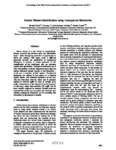Insider Misuse Identification using Transparent Biometrics
| dc.contributor.author | Clarke, Nathan | |
| dc.contributor.author | Li, F | |
| dc.contributor.author | Alruban, A | |
| dc.contributor.author | Furnell, S | |
| dc.date.accessioned | 2022-04-25T10:53:27Z | |
| dc.date.available | 2022-04-25T10:53:27Z | |
| dc.date.issued | 2017 | |
| dc.identifier.issn | 2572-6862 | |
| dc.identifier.uri | http://hdl.handle.net/10026.1/19064 | |
| dc.description.abstract |
Insider misuse is a key threat to organizations. Recent research has focused upon the information itself – either through its protection or approaches to detect the leakage. This paper seeks a different approach through the application of transparent biometrics to provide a robust approach to the identification of the individuals who are misusing systems and information. Transparent biometrics are a suite of modalities, typically behavioral-based that can capture biometric signals covertly or non-intrusively – so the user is unaware of their capture. Transparent biometrics are utilized in two phases a) to imprint digital objects with biometric-signatures of the user who last interacted with the object and b) uniquely applied to network traffic in order to identify users traffic (independent of the Internet Protocol address) so that users rather than machine (IP) traffic can be more usefully analyzed by analysts. Results from two experimental studies are presented and illustrate how reliably transparent biometrics are in providing this link-ability of information to identity. | |
| dc.format.extent | 4031-4040 | |
| dc.language.iso | en | |
| dc.publisher | Hawaii International Conference on System Sciences | |
| dc.title | Insider Misuse Identification using Transparent Biometrics | |
| dc.type | conference | |
| plymouth.author-url | https://www.webofscience.com/api/gateway?GWVersion=2&SrcApp=PARTNER_APP&SrcAuth=LinksAMR&KeyUT=WOS:000625875705056&DestLinkType=FullRecord&DestApp=ALL_WOS&UsrCustomerID=11bb513d99f797142bcfeffcc58ea008 | |
| plymouth.conference-name | Hawaii International Conference on System Sciences | |
| plymouth.publication-status | Published | |
| plymouth.journal | Proceedings of the 50th Hawaii International Conference on System Sciences (2017) | |
| dc.identifier.doi | 10.24251/hicss.2017.487 | |
| plymouth.organisational-group | /Plymouth | |
| plymouth.organisational-group | /Plymouth/Faculty of Science and Engineering | |
| plymouth.organisational-group | /Plymouth/Faculty of Science and Engineering/School of Engineering, Computing and Mathematics | |
| plymouth.organisational-group | /Plymouth/REF 2021 Researchers by UoA | |
| plymouth.organisational-group | /Plymouth/REF 2021 Researchers by UoA/UoA11 Computer Science and Informatics | |
| plymouth.organisational-group | /Plymouth/Users by role | |
| plymouth.organisational-group | /Plymouth/Users by role/Academics | |
| dcterms.dateAccepted | 2017-01-01 | |
| dc.rights.embargodate | 2022-4-26 | |
| dc.rights.embargoperiod | Not known | |
| rioxxterms.versionofrecord | 10.24251/hicss.2017.487 | |
| rioxxterms.licenseref.uri | http://www.rioxx.net/licenses/all-rights-reserved | |
| rioxxterms.type | Conference Paper/Proceeding/Abstract |


